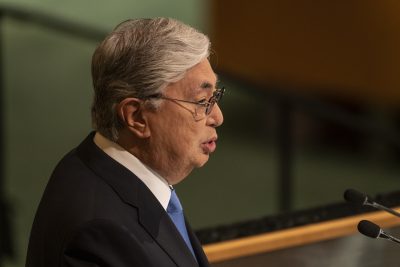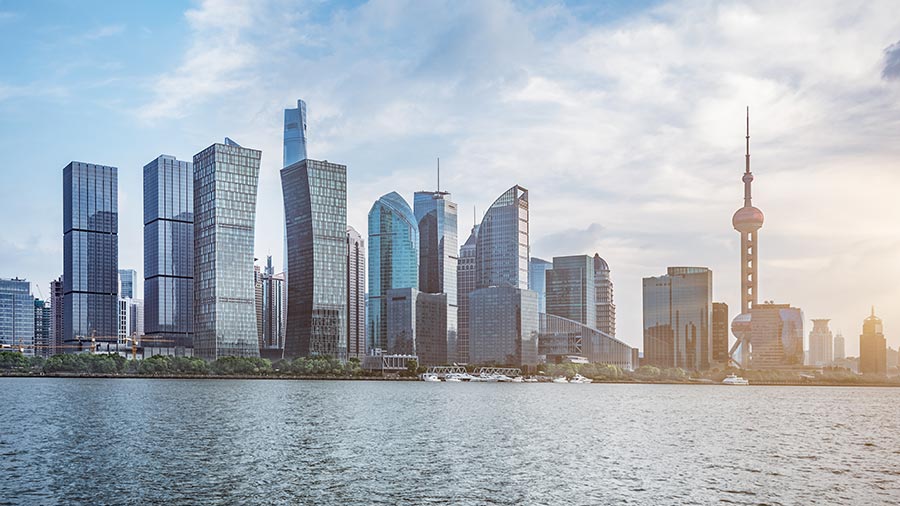China
Tokayev bites the reform bullet

Author: Marian Seliga, J&T Bank
In response to anti-government protests that broke out in Kazakhstan in January 2022, Kazakhstan President Kassym-Jomart Tokayev has called for reforms that might significantly change the country’s political landscape. Tokayev signed a decree on constitutional amendments on 17 September that limits presidential tenure to a single seven-year term and called for snap elections to be held on 20 November.
In September, Tokayev instructed his officials to prepare a new reform package that further ‘decentralises and distributes’ power between the government, ministries and regional heads (akimats). It envisages a mixed electoral system, simplified party registration procedures and increased regional independence. Tokayev has initiated the democratic process of expanding the powers of parliament while limiting the powers of the president.
But it would be wrong to believe that Tokayev intends to completely democratise this Central Asian country, ruled for many years by the authoritarian leader Nursultan Nazarbayev. Although Tokayev is not a typical political figure, he has been part of Kazakhstan’s establishment since the dissolution of the Soviet Union and is more typical of a Soviet cadre than a pioneer of democratisation.
It is naive to expect a man who has spent most of his professional life operating in authoritarian regimes to radically reform Kazakhstan’s political system. While he is very well educated, Tokayev represents the Kazakh elite, who prefer a reliable personality with great authority. Clan relations and respect for authority are very much rooted in this Central Asian country.
Tokayev’s calls for reform and an early election suggest that he is, first and foremost, trying to consolidate power and restore stability after the massive anti-government protests in January. The riots led to the deepest political crisis in the country and the deployment of Collective Security Treaty Organisation (CSTO) troops.
If his plan to consolidate power succeeds, it will bring an end to the biggest political crisis Kazakhstan has faced in its 30 years of independence. Shortly after the withdrawal of CSTO troops from Kazakhstan, the President promised a thorough investigation into the forces behind the January protests and a response to the major challenges that Kazakhstan faces. The investigation is ongoing, but Nazarbayev allies are losing power as Tokayev rushes to blame the old regime.
These political and economic reforms send a positive signal to foreign investors. But to fully repair Kazakhstan’s image and economic growth, Astana needs to pursue a balanced foreign policy and increase economic cooperation with the West and East.
Tokayev is expected to pursue independent foreign policy, as he is not limited by ‘patronage’ relations with Moscow like his predecessor Nazarbayev. At the 25th Saint Petersburg Economic Forum on 17 June 2022, Tokayev emphasised that Kazakhstan will not recognise the Donetsk and Lugansk People’s Republics as independent states.
Since the beginning of the Ukraine war, Russia has tried, with limited success, to push Kazakhstan into military and technological cooperation. President Tokayev has not backed Moscow’s military campaign in Ukraine and said in an interview with a Russian TV channel in June that Kazakhstan would not assist Russia in circumventing sanctions.
Kazakhstan will instead bet on closer cooperation with the United States and China. The United States is one of the largest investors in the Kazakh economy, with a direct investment inflow of about US$1.9 billion in the first quarter of 2022 — nearly twice as much as the same period in 2021.
China is also very active in Kazakhstan. It is no coincidence that Kazakhstan was the first country that Chinese President Xi Jinping, who had not left China for more than two years, visited ahead of his attendance at the Shanghai Cooperation Organisation’s summit in Samarkand.
Xi’s visit showed that China attaches great importance to strengthening relations with Kazakhstan. China has invested around US$20 billion into the Kazakh economy since 1991, reflecting its position among the top five foreign investors in Kazakhstan. Investments from China and the United States will provide a solid foundation for further economic development.
There is hope among Kazakhs that the reforms will continue after Tokayev is re-elected at the next presidential election. Tokayev is aware that providing economic security will help him consolidate power. That thinking was evident in Tokayev’s September…
China
China’s November 2024 Economy: Navigating Mixed Signals and Ongoing Challenges

In November 2024, China’s economy exhibited mixed results: industrial production rose by 5.4%, while retail sales grew only 3%, below forecasts. Fixed asset investment also faltered. Policymakers are anticipated to introduce measures to stimulate domestic demand and combat deflation.
China’s economy showed mixed performance in November 2024, with industrial production and exports showing resilience, while retail sales and fixed asset investment underperformed, amid ongoing challenges in the property sector. Policymakers are expected to implement targeted fiscal and monetary measures to boost domestic demand and address deflationary pressures.
The National Bureau of Statistics (NBS) has released China’s economy data for November 2024, revealing a mixed performance across key indicators. Retail sales grew by 3 percent year-on-year, a significant slowdown from October’s 4.8 percent growth and well below the 4.6 percent forecast. Industrial production, however, showed resilience, rising by 5.4 percent and exceeding expectations of 5.3 percent growth.
The property sector continued to drag on the broader economy, with real estate investment contracting by 10.4 percent for the January-to-November period, further highlighting the challenges in stabilizing the sector. Fixed asset investment also fell short of expectations, growing by 3.3 percent year-to-date, down from 3.4 percent in October.
In November, China’s industrial value added (IVA) grew by 5.4 percent year-on-year (YoY), slightly accelerating from the 5.3 percent recorded in October. This modest improvement reflects continued recovery in key industries, supported by recent stimulus measures aimed at stabilizing the economy.
The manufacturing sector led the growth, expanding by 6.0 percent YoY, while the power, heat, gas, and water production and supply sector grew by 1.6 percent. The mining industry posted a 4.2 percent YoY increase. Notably, advanced industries outpaced overall growth, with equipment manufacturing and high-tech manufacturing rising by 7.6 percent and 7.8 percent YoY, respectively, underscoring the resilience of China’s innovation-driven sectors.
Key product categories showed robust output gains in November:
From January to November, IVA increased by 5.8 percent YoY, maintaining steady growth over the year despite headwinds from a slowing property market and external uncertainties.
| This article was first published by China Briefing , which is produced by Dezan Shira & Associates. The firm assists foreign investors throughout Asia from offices across the world, including in in China, Hong Kong, Vietnam, Singapore, and India . Readers may write to info@dezshira.com for more support. |
Read the rest of the original article.
China
Ukraine war: 10% of Chinese people are willing to boycott Russian goods over invasion – new study

Since Russia’s 2022 invasion of Ukraine, some Chinese citizens express dissent through potential boycotts of Russian goods, reflecting a complex relationship despite government support for Russia.
Since Russia invaded Ukraine in 2022, the Chinese government has been criticised for its refusal to condemn the war. In 2024, the economic and diplomatic relationship between the two nations appears stronger than ever.
Because of strict censorship and repression imposed by the Chinese Communist Party (CCP), it is difficult to know the extent to which the general public shares their government’s support of Putin’s regime. But a newly published study I carried out with colleagues found that more than 10% of Chinese people surveyed were willing to boycott Russian goods over the war in Ukraine.
This is a surprisingly large figure, especially since existing surveys indicate that Chinese people hold a broadly positive view of their neighbour. We used a representative sample of 3,029 Chinese citizens for this research, to dig into public attitudes to Russia. The survey was done in 2022 after the Ukraine invasion.
We were aware that due to widespread censorship, our participants might not be willing to give honest answers to questions about Russia’s actions in Ukraine. They might also not feel safe to do that in a regime where disagreement with the CCP’s position is often met with harsh punishment. This is why we asked them to tell us if they would be willing to boycott Russian products currently sold in China.
We felt this question was a good indicator of how much the participants disapproved of Russian foreign policy in Ukraine. More importantly, we were also curious to find out whether Chinese citizens would be willing to take direct political action to punish Russia economically for its aggressive behaviour.
In our study, we split respondents into the three different ideological groups in China: “liberals”, who support the free market and oppose authoritarianism; “the new left”, who sympathise with the policies pursued in China under Mao Zedong; and “neo-authoritarians”, who believe the Russian-Ukrainian conflict is an extension of the rivalry between authoritarian China and the liberal United States. These groups were based on the main political beliefs in China.
We found that liberals were most likely to say they were willing to boycott Russian products. Liberals believe that China should work with, rather than against, western democracies. They also place a high value on human rights and democratic freedoms. Because of their beliefs, they are likely to think that Russia’s actions against Ukraine were unprovoked, aggressive and disproportional.
Chinese and Russian economic and diplomatic relations seem closer than ever in 2024.
American Photo Archive/Alamy
The new left and neo-authoritarians we surveyed were more supportive of Russian products. The new left see Russia as a close ally and believe that Nato’s expansion in eastern Europe was a form of aggression. Neo-authoritarians, on the other hand, believe that supporting Russia, an allied autocracy, is in China’s best interest.
Boycotting Russian goods
Asking Chinese participants if they are willing to boycott Russian products might seem like a simple matter of consumer preferences. However, our study reveals a great deal about the way in which regular citizens can express controversial political beliefs in a repressive authoritarian regime.
Boycotting products of certain companies has long been studied in the west as a form of unconventional political action that helps people express their beliefs. However, in the west, boycotting certain products is simply one of many ways people are able to take political action. In a country such as China, boycotting a Russian product might often be the only safe way to express disagreement with the country’s actions.
This is because citizens do not have to tell others they chose not to buy a product, and their actions are unlikely to attract the attention of the authorities.
Since Russian goods are readily available to Chinese consumers and China is encouraging more Russian exports to reach its market, the Russian economy could be significantly affected by an organised boycott campaign in China. The considerable level of support for a boycott expressed by some of our participants, as well as previous acts of solidarity with Ukraine in China, suggest that such a campaign could already be taking place in the country.
This could harm Russia because it regularly exports a number of different products such as meat, chocolate, tea and wine to China. These goods made up 5.1% of China’s total imports in 2023 – and this figure is likely to increase if Russia becomes more isolated from the west, and therefore more dependent on China for its trade.
While 5.1% of the Chinese market might seem like a low figure, China is home to over 1.4 billion people. In this context, even a small boycott could result in a serious loss to Russian companies.
Our research shows that Chinese citizens don’t always support the official position of the communist party. It also shows that many people there will express even the most unpopular political opinions – if they can find a safe way to do it.
This article is republished from The Conversation under a Creative Commons license. Read the original article.
China
Australia Can Enhance China’s Credibility in the CPTPP
In early 2024, China sought to join the CPTPP, potentially offering modest economic benefits to Australia. Key reforms include limiting state-owned enterprise subsidies, enhancing data flows, and banning forced labor.
China’s Interest in the CPTPP
In early 2024, China expressed a keen interest in joining the Comprehensive and Progressive Agreement for Trans-Pacific Partnership (CPTPP), a trade agreement involving eleven Pacific Rim economies and the United Kingdom. This move is anticipated to yield modest economic benefits for Australia. However, it also opens the door for vital reforms in areas such as the control of subsidies for state-owned enterprises, allowing free cross-border data flows, and prohibiting forced labor practices.
Economic Implications for Australia
A May 2024 report from the Australian Productivity Commission indicated that China’s accession to the CPTPP might raise Australia’s GDP by only 0.01%. This modest gain isn’t surprising, given Australia’s existing preferential trade arrangement with China through the Regional Comprehensive Economic Partnership. Nonetheless, the CPTPP encompasses more than just tariff reductions, focusing on broader trade principles and standards.
Reform Commitments Required from China
For China to become a CPTPP member, it must demonstrate adherence to high-standard rules initially developed with the country in mind. This commitment will help alleviate concerns among member nations like Japan and Canada, particularly regarding China’s economic practices and geopolitical tensions, such as those with Taiwan. Membership would necessitate reforms, including limiting SOE subsidies, enabling freer data flows, and banning forced labor, with significant penalties for non-compliance.
Source : Australia can encourage China’s credibility in the CPTPP






